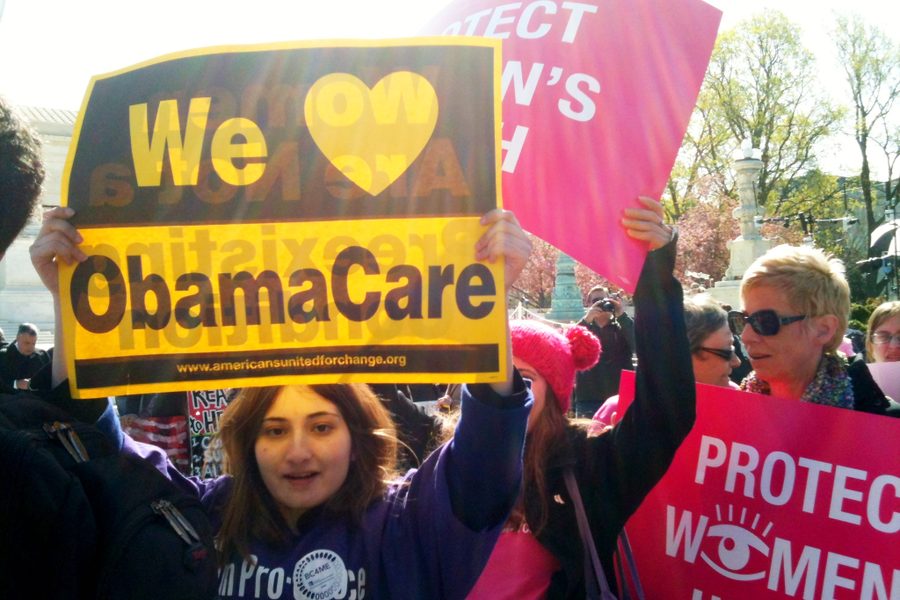How Obamacare Is Actually Preventing Americans From Escaping Poverty
Obamacare was intended to alleviate the health cost burdens for the working and middle class. But in practice, it often works differently.
Darlena Cunha

Obamacare is leaving the middle class behind.
Not the living-in-suburbia, driving-an-SUV-to-soccer-practice middle-class dream (although it affects people living that dream negatively, too), but the new middle class of America — the ones struggling to pull themselves out of the hole after the economic crash. The middle class that is so close to poverty that one wrong move will land them there, but just far enough away from hopeless debt that the states and the federal government figure they can fend for themselves. Which many of them probably could have, before the Affordable Care Act.
This is not because Obamacare is a bad idea. It’s because it is not being allowed to function correctly in its attempt to extend affordable health care coverage to more Americans.
Do a quick internet search for the ACA and you’ll happen across dozens of articles decked out in hyped-up jargon talking about Supreme Court Cases, appeal efforts in the legislature, convoluted battles between state and federal initiatives and rising premiums in statistical language. What you don’t see is what is happening to the people on the plans — and more importantly, why the ACA is marred by multiple impractical setbacks.
The crux of the problem is this: As soon as an individual or family finally moves above the federal poverty line, their insurance premiums and deductibles can skyrocket into the tens of thousands — meaning if they make use of this plan, they may well end up worse off financially than they were when considered impoverished.
According to the McKinsey Center for U.S. Health System Reform, 70 percent of those who make enough not to be eligible for Medicaid but who still qualify for a subsidy — a tax credit for those with lower incomes — will likely see their premiums go up in the coming year. The closer to middle class a family becomes as they try to dig out from poverty, the higher the hit in health care, making it nearly impossible for hardworking families to move forward financially.
Take Bree Casson, for example. Casson is a single mother of three who works part-time at a fast food chain and goes to school in Maine. Her family is covered by Medicaid, but if she makes any more money, they’ll be kicked off that plan and forced to buy insurance she can’t afford. Knowing this, Casson makes sure she doesn’t work more than 30 hours a week, effectively keeping her income low enough to afford her health coverage.
Under a different system, she said, like single payer, she could start moving her way up, working more hours, becoming self-sufficient and independent. “A single-payer healthcare system would give us more choices and better care, and keep us covered longer” Casson said. “Right now, my family is covered, but I just got another raise, and soon I’ll make too much to qualify for Medicaid. Other than my son with a disability, we’ll all be kicked off the plan, and even making the highest salary at my current job, I absolutely cannot afford even the cheapest of health plans.”
Where things stand now, Casson cannot afford to try to make the jump to middle class. She must choose to be poor to be able to feed her family.
The fuzzy math is this: Say someone with two children makes $35,000 a year, gross. They give about $6,000 of that back in taxes, another $12,000 for rent or mortgage, $2,500 for house maintenance bills, and about $7,500 for groceries. This means they have earned, that year, $7,000.
For argument, let’s say normally insurance costs them $200 a month. Their take-home pay for the year now becomes $4,600. This is doable. It’s not great, but it is surviving without government help.
Now say premiums jump to $400 a month, which they have for many people. Their take-home pay for the year is now $2,200. Deductibles on some of the silver ACA plans range anywhere from $2,800 to well over $12,000, depending on where you live and who you are. Even the lowest deductible on that plan puts the family on it in the red for the year. Do that for a few years, and that family is now in debt, even while they seemed to be making ends meet on paper.
While it’s impossible to generalize the experience across the nation as rents vary, taxes vary, bills vary and how people file varies, many individuals, despite their disparate circumstances, all share a similar story. In fact, the Congressional Budgeting Office projected earlier this year that 2015 will see 36 million people left out of the program .
Mike Margerelli is a single man in his twenties working in Connecticut. He’s chosen to go without insurance and pay the price. The yearly penalty for being uninsured is either 2 percent of your taxable income or $325 per person with a max of $975 per family, whichever is higher.
“I make too much money for Husky,” Margerelli says, referring to Connecticut’s Medicaid plan, “but not enough to afford the adjusted plan, at $230 a month with a $3,500 deductible. The state’s health Marketplace rejected my request for hardship, based on my bills. In my opinion, the flaw in the system lays in the fact that they place you in a plan based on income, not realizing that people still have to pay for stuff with that income. This is my second year with no health insurance.”
Going uninsured is nothing new. Healthy, single people in their 20s like Margerelli have been doing so with little consequence since well before Obamacare. They bet against the insurance companies that they will not need medical care. But what happens when those 20-somethings start having children?
Judith Huntley lives in Florida with her husband and young daughter. She works in realty and her husband waits tables. Neither have insurance options through their employers; they shop for their insurance through the ACA Marketplace. They cannot afford her health plan, so her family goes without.
“For my husband and I, plus a two year old, the cheapest plan is $625 a month with $12,500 deductible,” Huntley said. “So, we would pay them $7,500 this year and the first $12,000 and hope our healthcare expenses cost us more than $20,000 this year to make it all worth it? No. I’d rather pay any tax penalty they throw at us and pay out of pocket like we normally do for her physicals and our random strep or sinus infection.”
President Obama’s original plan outlined a single-payer system, which means the government must provide insurance to its population regardless of income level. It’s a socialized medical system that was met by much balking on either side of the political aisle, though one that has been successful in countries like Canada.
Because of intense lobbying by private insurance companies, Obama had to modify his plan, not least by allowing those who wanted to keep their private insurances to do so. This led to mixed politics and unmatched systems in that for a short time, some healthy, young individuals remained exempt from paying into a system that caters to all people. It also allowed gaps in policies, like insurance plans which didn’t cover maternity costs, to remain. By allowing people to keep the insurance they previously loved, and not streamlining the coverage with hard and fast rules, those private insurances were forced to change their plans anyway due to free-market pressure, and yet were still allowed to inflate costs and cut corners to maximize their profits.
With the compromised system of private and public health insurance, in addition to the mandate that everyone must be insured and with a scale resting on income alone, the healthy middle class members are now paying for the privilege to pay for their medical care by themselves — as in, they pay their premiums every month, then never hit the deductible cap and so pay for their medical costs out of pocket anyway. And if their income is more than they expected, they can expect to be taxed for it.
“One word of warning that we provide people with respect to ACA is that the subsidy you receive through the marketplace is actually a tax credit,” said Kate Hutton, who works in human resources for Power Specialists Association in Connecticut, a private insurer that operates through the Marketplace. “So if your income increases after you’ve signed up for ACA, and you don’t report it to the marketplace, at tax time you may find yourself with unforeseen tax liabilities.”
To break that down a bit, when you receive a subsidy from the government to counteract prohibitive costs, it doesn’t come without caveats. The amount a family receives in supplemental help depends directly on the amount of money that family is bringing home. Should that number go up during the year, the family who thought they were being helped may end up having to pay back the subsidy money through their taxes.
Then there are the people who are suffering a stumble in their finances. The ACA as it stands can be crippling for them.
Tiffany Yusup is a single woman living in Connecticut who recently lost her job and applied for free health care through Medicaid while on unemployment. She didn’t qualify and will have to pay for her coverage.
“Even with the subsidy credit, for me to have decent insurance would still cost me $100 per month. I can’t afford that on unemployment with my other bills,” Yusup said. “So basically my choices are to not have health insurance or to default on my student loans. And if I don’t find a new job with insurance soon, I’ll be fined for not having insurance when I file my taxes next year.”
This isn’t to say the ACA is a bad idea in theory, or even in practice. There are many, particularly poor Americans, who are now benefitting greatly from the plan.
Sarah Campillo-Laughlin resides in Washington and her income varies as an artist, but she makes little enough to be covered under extended Medicaid. She said for the first time in her life, she is able to afford both the medical and dental attention she needs, including expensive medications.
Allison Williams lives in Michigan and said the ACA has helped her immeasurably due to how little she makes.
“It is the first time in my life that going to the doctor doesn’t leave me humiliated and weeping about how I’m going to pay for it,” Williams said. “Depression pills, birth control and self esteem. I hope we go to single payer because everyone should have this. It has changed my life.”
The ACA helps families in need, too. Sarah Yarnes works for the Department of Veterans Affairs in Connecticut and doesn’t get insurance through her employer, so she and her daughter rely on Husky Medicaid to make it through. Like many, for Yarnes, the stigma of assistance is still strong.
“It’s an amazingly generous plan,” she said, “but the shame of needing government assistance still weighs on me.”
With so many in need benefiting from expanded Medicaid options and the Children’s Health Insurance Program, to say that Obamacare is failing, full stop, would be wrong. But it is marred by the compromises legislators made in constructing it. By allowing insurances to remain mostly intact while still implementing a forced healthcare plan on the American people, we’ve left the profit motive intact as a central concern in our health care system. If we allow it to remain, we will continue to let our society’s vulnerable fall through the cracks.
What we need is an expansion of the Medicaid benefits to those attempting to work their way above the Federal Poverty Line, not a repeal of the program or more clinging to the free market insurance plans of old. We need a complete embrace of federally available insurance for all citizens — not so the government has more control over us, but so we have more control over our own health.
Obamacare was put into place to solve the massive problems America faces in terms of medical costs; those costs are the number one reason for bankruptcy claims. But as the working and middle class continue trying to claw their way into financial security, and the program that is supposed to be helping them by alleviating health costs burdens is all too often actually pushing them back into poverty.






